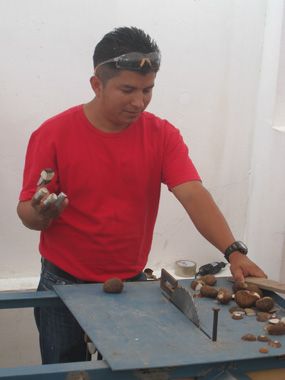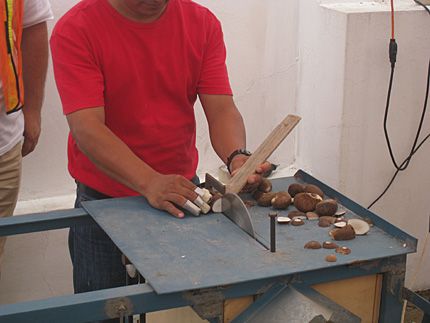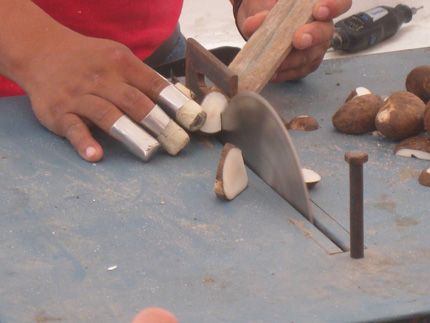
Don't try this at home. In the village of Montecristi, Ecuador, woodworkers don't really have access-or funding-for modern, safety-conscious woodworking equipment.
Ever since the now infamous Carlos Osorio tablesaw lawsuit, woodworkers around the country have really zeroed in on tablesaw safety and the potential effects of new CPSC legislation on the price of workshop machinery. In South America however, most folks either don’t have the cash required to purchase an expensive safety-conscious saw, don’t have access to the technology, or just aren’t as dialed into tablesaw safety as the developed world might be.
 While in Montecristi, Ecuador recently I visited a craft shop that produces a variety of items like jewelry and buttons fashioned from tagua nuts. Tagua nuts, also called vegetable ivory, come from 15-18 foot tall palm trees which grow in tropical rain forests. The nuts are typically about 2-in. in diameter, and the first step in making an item is to slice the nut into the desired shape or thickness. Due to the hardness of the nut, a tablesaw is used for the slicing procedure.
While in Montecristi, Ecuador recently I visited a craft shop that produces a variety of items like jewelry and buttons fashioned from tagua nuts. Tagua nuts, also called vegetable ivory, come from 15-18 foot tall palm trees which grow in tropical rain forests. The nuts are typically about 2-in. in diameter, and the first step in making an item is to slice the nut into the desired shape or thickness. Due to the hardness of the nut, a tablesaw is used for the slicing procedure.
So imagine my surprise when the demonstrator slipped a set of metal guards onto his fingertips and proceeded to saw off a series of slices using his fingers to hold the irregularly shaped nut. This is their standard operating procedure, no joke! No Sawstop, no holding fixture, no concern about tablesaw safety, just metal-tipped fingers within an inch of the blade. Luckily the operator still had all of his fingers intact.
It really makes a person think: perhaps we take our access to modern woodworking equipment for granted!



























Comments
how do you know that there are fingers under those guards?
That causes chills down my spine.
He's clearly using a pushblock! AND he has googles, they're doing a great job protecting the top of his head. Whats the problem? ;)
Wow, that is insane! The still shots make me a little nauseous, thankfully there is not a video because like the accident you can't look away from, I'd have to watch it.
sorta reminds me of the old 1960s space race development where the US spent millions developing a pen that wrote in zero gravity. And the Russians used a pencil!
Isn't that a lugnut taped on his index finger? Crazy!
I'd like to send that guy a bandsaw. Now, for more important issues, NASA never spent any money developing a pen that would write in space. It's an urban legend. The pen you are speaking of is the Fisher space pen (a great pen, by the way), which was developed by Paul Fisher. He developed the pen independently, without any government funding. After he had developed it, he approached NASA about it and they began to use it. Prior to that, they had used pencils. The Soviet space agency also began to use the pen.
Why not stick with pencils? Here's why: "the substantial dangers that broken-off pencil tips and graphite dust pose in zero gravity to electronics and the flammable nature of the wood present in pencils."
Matt:
Has anyone used the term "geek" before when speaking about you? LOL
yes, I've been called a geek. But that's OK. There's nothing wrong with a strong devotion to the truth.
I would love to see someone sharpen a pencil in weightless conditions…
Although I am not an attorney, I have swum with the sharks for most of my career. I humbly submit for your consideration the following:
Observations:
1) The subject is using a push block in his left hand.
2) The pushing/holding fixture includes a "top arm" and "rear arm" that would effectively deflect a kickbacked or uplifted projectile to the left or right, thus sparing the operator's body from a direct impact.
3) A presumed v-notch in the crosscut fence to stabilize the irregular and variable shape of the nuts. There is no way this process would work consistently without a v-notch in the crosscut fence.
4) Safety goggles, but no hearing or face protection.
5) And, yes, it looks like there's a big hunk of metal (lug nut?) under the tape on the index finger.
6) The mere presence of finger guards, whether effective or not, clearly demonstrate risk recognition, which is the first line of defense against injury.
Findings:
1) The bio-forces are being applied from the rear and the left, and only gentle holding pressure (if any) is being applied from the right.
2) Kickback and uplift potential are adequately addressed.
3) Right hand pressure ANGLED TOWARDS the blade is very slight or perhaps even non-existent. The right hand is more likely only tracking the forward movement.
Conclusions and Recommendations (assuming the above observations are true:
1) Risk of finger injury resides within this author's personal risk tolerance level (barely).
2) Hearing protection should be required. Face shield too.
And what's with that hex bolt rising up from the table on the trailing edge of the blade? A riving device? We need a video.
I would point out that the NASA spent millions on a pen thing is a myth, a short search on google would show it started as a viral email a number of years ago but lacks the facts ;)
I have been working with Tagua nuts for over 20 years. I was taught to soak the nuts in water before you work with them. Depending on the size of the nut, you may have to soak it for up to 2 weeks. This makes the nut soft enough to easily cut with a knife, carving chisel or even a coping saw. There was not any need for a tablesaw. After you are done carving them, let them dry. They will get as hard as they were and there has never been any cracking. That being said, they probably do not have the time to let them soak first.
handtool37 writes:- Maybe i have a different out-look on what is happening. This guy, except for face protection, has protected himself exceedingly well. The metal finger guards prevent his fingers and thumb from being cut by the blade, which appears to be rotating towards him therefore pressing the nut into the table top and towards him and is being held by up to 4 clamping positions, ie. his protected fingers. The tape around the finger guards is for better grip. He is also holding the nut down with a notched push stick in his left hand. The whole cutting takes place in the 1st quarter of the blade diameter therefore there is no danger of pick-up and throw, and there is zero clearance between the blade and the table. So all in all they seem to have a reasonable safe working practice for which having a table saw with saw-stop etc would not be cost effective. Is this an any worse practice than that used in the meat/fish preparation industries where the operatives use chain - mail protective cloves etc. whilst using knifes and power saws of all descriptions!!.
Also if we are talking of safe working practices I remember seeing a video produced by FWW showing how to grind a chisel/plane blade where the grinding wheel was completely unprotected.
The bolt on the outfeed of the saw is obviously there to hold the fingerguard lugnut when not in use. Another simple way th keep your PPEs in a easy to access place.
But at least he has a study splitter.
No matter how he did it, the piece (pic buried bottom left of article) he created was spectacular. I understand 3rd world economic restrictions and have seen far worse examples when it comes to safety. The artist always uses what he/she has to assist a blessed hand and a good eye. Third world artist are some of the best and they have so little tools to work with. I have the tools, but my hands are not so blessed.
Do you have other pictures of his work?
If he has the cost of shipping I have a 12' Craftsman bandsaw I'll send him. With extra blades, fence, miter gauge, and sanding belts.
Opps! I meant 12". Is there such a thing as a 12' one? Just curious.
I'm not even sure that is a table saw. Table saw blade for sure. Home made apperatus means there is no manufacuer to sue!
chevypdx is on the right track. The fact that this guy works like this and has done it long enough to be able to produce such nice work tells me that he is very aware of safety, respectful of the saw, and most important, understands the forces involved. In addition to chevypdx's observations, I would also note that his right hand is resting on the saw table. This is a very important safety consideration and one that everyone should become familiar with. If the hands are well anchored to the table and the blade grabs the work, he might get a bruise on his forehead, but his fingers aren't going to wind up in the blade because they are attached to his hand which is resting on the table away from the blade.
I used to cut pebbles in half when I was in the fountain business. I used a regular MK-101 tile saw with a sliding table and I just hand-held the pebbles - down to 1" diameter - as I slid the table through the blade. Notice I did not say that I pushed the pebble through the blade. By anchoring my hands firmly to the table I was able to ensure that all my fingers remained intact, which they did.
I also use this technique with the bandsaw. I have put in a tremendous amount of time in front of the bandsaw. If you are cutting a small piece and must hold it close to the blade, you rest your left hand firmly on the table, hold the wood with your fingers - I do keep them as far from the blade as is practical - and cut slowly. If the saw grabs, you are not leaning on the piece and it cannot pull you into the blade.
It seems like the kind of thing that should be common sense, but it is not. Instead, too many people rely on technology to keep themselves safe, rather than on their brains.
And one thing that freehand cutting does is keep you focused. If you are not able to focus, then maybe it's not for you.
I do agree about the face shield, though. His biggest risk is that a grab will pup the nut up and give him a knot on the forehead. :-)
BTW, the guy standing behind him has an orange vest on. That has to count for something...
I think we can all learn from this guy. He obvioulsy knows his tool and has a serious respect for it. he knows the risks and has calculated what it will take to help minimize the risk with jigs and fixtures. Besides we in north america use dado stacks which are outlawed in europe for how dangeruos they are. I feel cumfortable with the precautions I take when useing one. If you want a safe table saw buy a Bridge City tool works saw.
A table saw isn't dangerous, it's the idiot using it. Do things properly and you'll never get hurt.
I am an ex-pat living in Ecuador for many years and have a carpenter shop on my farm. Most of the guys I know working in carpenter shops here are all missing parts of fingers and they are breathing sawdust all day. Americans like to think they are over-regulated and when they come to a place like Ecuador which has no safety or health regulations for there workers they think wow how free but they don't see all the accidents.or
The horrible lung conditions these people suffer through. I personally think Americans should be thankful for many of the health and safety regulations they have in place.
Thank you for the opportunity to share my thoughts,
Ira
gsm627: Never say never! // As much complaining about government involved in our lives as we do, all must realize how we really couldn't survive or prosper without it. Employee safety (like this guy in South America could use)has a lot owed to government rules/regulations/laws. I thank the farsighted help from governments!
It is a sad commentary on America to read these panygyrics to government involvement in private matters. Perhaps this is to be expected from a New England-oriented audience. Instead of effusing about how lucky we are that the government protects us from ourselves - try keeping your damn hands away from spinning blades! That's worked for me for 50+ years.
Once we surrender our freedom to forced micromanagement, as have NYC voters, there's no limit to what we will be made to do - for our own good, of course.
He needs a GRR-RIPPER....? Me thinks!
He needs a GRR-RIPPER....? Me thinks!
I have seen homemade table saws made with a piece of plywood, and a universal arbor, that the table tilted to adjust the height of the blade.and i have also seen, and worked with, a handheld circular saw, mounted upside down to a piece of plywood.
Table saw safety, in reality boils down to a concept that is not in favor right at the moment, the concept that the condition of one's fingers is your own personal responsibility, and if you want to keep them, you will pay attention.
Now that I look at this, though, I think we may be looking at this wrong.. In truth, this is a nut slicer, not a tablesaw, so tablesaw rules don't apply.. this a similar concept to the fact that you can get a ticket for driving a 4 door sedan without a seatbelt, but should you decide to ride a motorcycle, you can do so, in shorts and flipflops, without a helmet, and take a similar near-naked person with you, at 70 mph and no one will say a word...
There are gloves for meat cutting bandsaws for $13.00 that prevent injury from band saw blades utilized in butcher shops. I don't have an opinion if they would
be more dangerous or safer on a table saw because I have never tried or worn a pair.
In Latin American countries most small carpenter shops use home built table saws because of cost and there is really nothing to break that can't be repaired fast and on the cheap. The arbors that holds the blade and have a pulley on the other end are sold at just about any decent hardware store for forty to a hundred US depending on the size.
Hay que tener mucho cuidado!
I cannot believe people need government to tell them not to stick their finger into a blade , no wonder our country is going to he'll in a hand basket we have become a country of idiots.
I could survive and prosper gladly without the government if they would just get out of the way and leave me alone.
As an ER doc, I am ambivalent about government control of my life. I treat my tablesaw with the greatest respect (and some fear as well) because of all of the injuries I have seen. I think we should be free to choose, but a lot of people choose badly and we as tax payers end up paying the bill. We have a saying : "Stupid pays the bills.", and there is a lot of stupid out there. Like motorcycle helmets, some mandates protect people from their own stupidity. Seat belts and airbags make my job easier because I do not have to tell families about deaths as often. I really hate having to do that. On the other hand, the government cannot run anything well including itself. I have seen some really bad hand injuries from tablesaws. Could those injuries have been prevented using simple safety procedures...Probably, Would I like to have a Saw Stop..You bet. But that would not change my safety procedures. People (except in a few cases) are responsible for their own safety and health which is something that the people pushing Obamacare ignore. My $0.02.
I believe some of the comments are missing the point. Yes, you can use common sense and be responsible for your own safety. That does not mean persons in authority (govenment of employer) should be able to abrigate responsibility for workplace safety. Given the opportunity I am sure they would say in a flash , it's the employees personal duty of care, not us.
This is why the WH&S laws exist, to stop unsafe exploitation of vunerable workers by persons in authority.
How many employers would have outlayed the huge amounts of money to extract fine dust or vapor from the air people work in if there was not a law to make them spend the money.
I saw a recent photo of a young woman of child bearing age, in a third world country, scooping out DDT from the large drum that the French manufacturer supplied it in, and weighing it into smaller plastic bags, she had black skin that was white from the DDT dust that had settled on her. She had been given a surgical mask to "protect" her. Do you want that for your daughters or sons in your USA or any where else???? It's those annoying, over regulated WH&S laws that prevent it.
Just plain nuts. Oops sorry for that. I had the misfortune to have a nut like this in my shop many years ago. One day my father is warning him to take it easy on the table saw to which he replied,"hey I've still got all ten fingers" and the next day my son is cleaning out four of those ten from the saw dust under the saw. Don't take chances, it's not worth it.
joefree77: That is NOT a job I think I could handle (cleaning up the "detritus" left behind. Yikes!
Best,
-Ed
Actually I was in Montichristi this week and visited a similar factory and too was shocked at the process. On one side of the blade the operator holds the nut in their metal clad fingers and on the other side they position the nut with a small stick and move the nut through at about 8-10 strokes per minute. How they can concentrate and not have a mishap is beyond comprehension! All the workers had all their fingers, so either the process works or those who fail find other employment. On the other side of the factory they were trepanning out buttons from the slices also with their hands in proximity to the augers. And these workers are paid a whopping $320/month for an 80 hour week.
sawdust maker: We are lucky to have access to better machinery, better techniques, and better working conditions. It's worth reflecting on from time-to-time.
Best,
Ed
In reading this discussion I can't help thinking we are comparing apples to oranges when it comes to machine safety. On the one hand we have readers who constantly bemoan government regulation as the great satin ruining their lives. If you want to go back to early industrial revolution conditions: digging coal half submerged in freezing water and liable to be crushed by a cave-in or explosion at any minute, being fired because you were stupid enough to let your hand be crushed in a punch press towards the end of your sixteen hour shift, or if you are a woman, letting a drug addled "physician" shove crochet hooks up your vagina to abort a child conceived after your shop foreman raped you after a full day at the loom, then may I suggest you move to Ecuador...or Bangladesh, or China. Because where safety is concerned, government regulation is pretty much non-existent in those countries, but if you published enough of your anti-government blabber online in one of those countries (which you have every right to do here in the Good Ole US of A) then your wife or husband might find you missing someday and never see you again.
On the other hand, if you want to make a jewelry box for your niece's wedding present in your garage then you have every right to run your hand or face or whatever through your tablesaw. However, if you are an employer, as I am, and you require your employees to engage in dangerous operations for your profit, then you are obligated to train those employees in the proper use of the equipment that they will be required to use, you are obligated to provide them with a safe working environment, and you are obligated, if they are injured, to make sure their medical needs are met; because if they are injured on the job, then you have not done your job properly.
Of course, in the US, Canada or Europe and in 2013, NO ONE ever has to work two jobs in unsafe conditions to make the ends meet.
From the comments here I get the impression that there are two extremes: you are either an Ecuadorian w/missing digits or a happy, healthy well-protected American. There seems to be precious little middle ground. Two seemingly opposing ideas can exist, and be true at the same time in this world. That some areas of the world are woefully far behind in safety, while in others you have safety inspectors insisting that a deaf worker put on ear protection (true story, although allegorical). I think it has as much, if not more, to do with prosperity and cultural capital as proper application of government policy. If the the government of Ecuador were to pass stringent safety regulations-how likely would it be to effect this guy or others like him?
Anybody got a used band saw we can ship down there?!
Log in or create an account to post a comment.
Sign up Log in